Brief

한눈에 보기
- The flood of investment into new online grocery delivery models is more evidence of the channel’s bright future, but it won’t determine winners and losers alone.
- We see three strategic realities shaping the sector instead: omnichannel grocery’s advantage in scale and customer intimacy; the need for quick-commerce players and incumbents alike to fix their economics; and the importance of diverse fulfillment methods across the sector.
- By introducing new competitors and new approaches, today’s disruption and experimentation could eventually solve the most intractable challenges in online grocery.
Around the world, online grocery is in flux as new services hustle for market share, fueled by billions of dollars of venture capital and other investment. Globally, quick-commerce players such as Gorillas, Getir, and Gopuff are taking on-demand convenience to a new level by delivering groceries in minutes. Aggregators such as DoorDash and Deliveroo are blurring the boundaries between meal delivery and grocery ordering. And unexpected collaborations appear by the day (such as tie-ups between Uber and Gopuff, and Tesco and Gorillas) as all parties battle for market share.
The surge in innovation fits our belief that online grocery will continue to gain popularity after going mainstream in the lockdowns of 2020 and 2021. Many of the tens of millions who tried it out of necessity are now regulars out of choice, won over by its convenience. But even though the money pouring into exciting start-ups is another sign that the future is bright for online grocery, the wave of investment doesn’t mean that disruptive newcomers are bound to get the upper hand over traditional grocers.
Working with online grocers and start-ups globally, we’ve pinpointed three strategic realities that should have a much bigger influence on the fate of incumbents and disruptors alike as they race to scale up capacity to meet rising demand.
- Reality #1: Omnichannel grocers retain a scale and customer intimacy advantage over quick commerce, but they need to stay vigilant.
- Reality #2: Fixing the challenging economics of online grocery is no longer an urgent job for incumbents alone—it’s an emerging priority for quick-commerce players too.
- Reality #3: Figuring out fulfillment is a common challenge for both traditional grocers and disruptors, but most players will have to find a blend of different solutions—and some capital expenditure will inevitably be wasted in the process.
To us, these are hard truths about today’s disruption that will help shape tomorrow’s industry. Yet while investor funding alone may not determine winners and losers, the influx of cash could end up unearthing solutions for some of the most intractable problems in online grocery. And that’s another reason to look ahead with keen anticipation.

Forge Retail presents – The Future of Delivery
Join us on Thursday, April 21st from 11:00 AM - 1:00 PM ET (Eastern Time), for our next Showcase event as we speak with industry leaders and insurgents about the latest innovations in delivery technologies, including quick commerce pioneers, autonomous delivery solutions, and automated supply chain enablers.
Reality #1: Omnichannel grocers retain a scale and customer intimacy advantage
The convenience of online shopping hasn’t suddenly made the physical store an obsolete asset. In fact, a recent Bain & Company survey showed that most online grocery shoppers still use stores for their grocery shopping too. In France, for instance, 93% of online grocery shoppers also shop for groceries in-store. Physical stores are still pivotal, even in markets where online grocery is very advanced, such as China. There, the proportion shopping in both channels is only slightly lower than in France at 89%.
Omnichannel customers in France and China
Proportion of grocery shoppers using both online and in-store channels
Omnichannel incumbents remain inherently larger than their challengers. But greater scale is not the only advantage of operating both a network of stores and an online grocery service. Omnichannel players also know more about the full breadth and depth of customer needs because they are tapping the biggest market opportunity: the “full basket” shopping mission. Quick-commerce players’ ultra-convenience mission makes it hard to build the same degree of customer intimacy, even with strong sales momentum. That’s because they are only serving targeted needs from a narrow selection of products (2,000–3,000 SKUs in a typical European quick-commerce dark store).
What’s more, omnichannel shoppers are a big prize from a revenue and margin perspective. In the US, they tend to spend almost as much per month as their online-only or store-only counterparts combined, chiefly because they buy more frequently, both online and in person (see Figure 1).
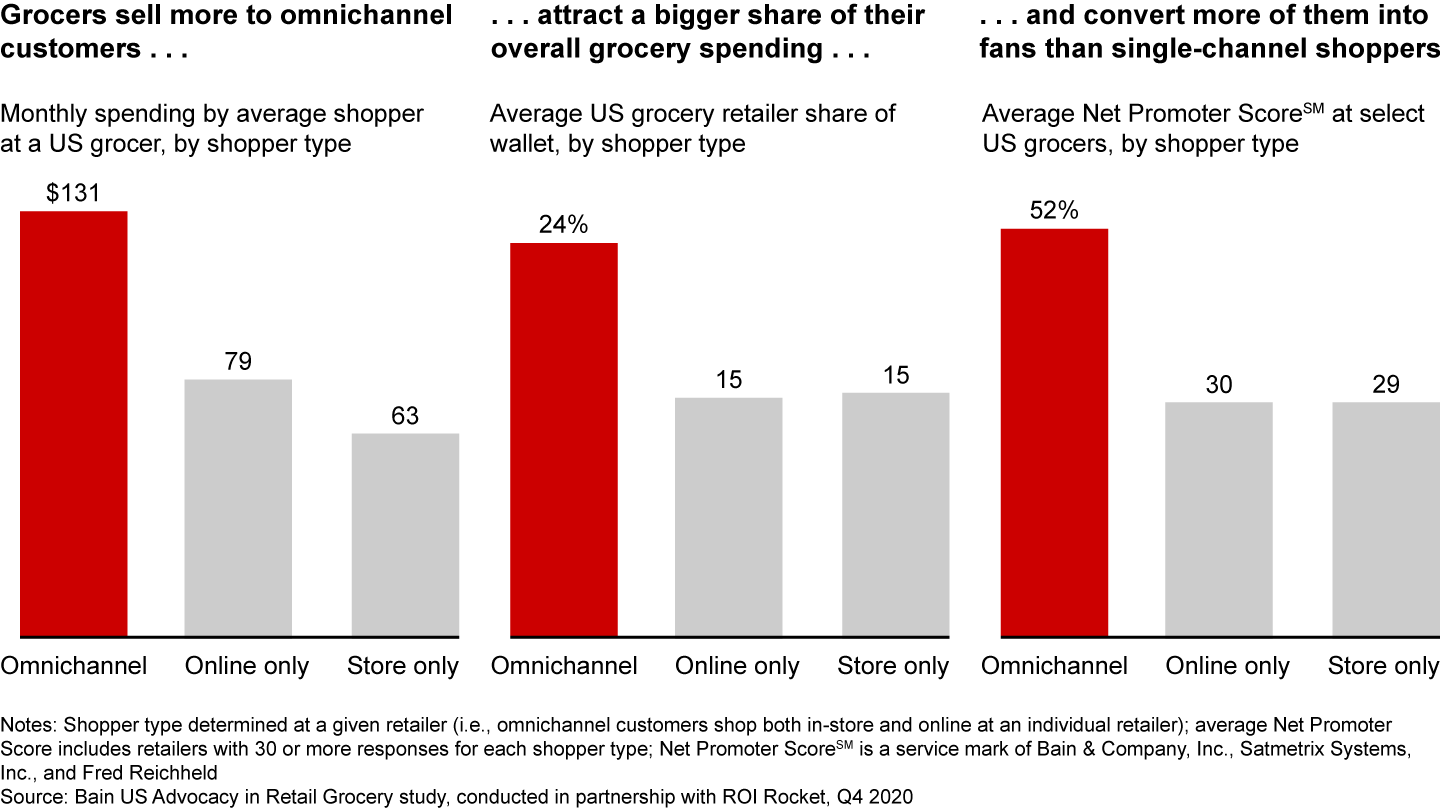
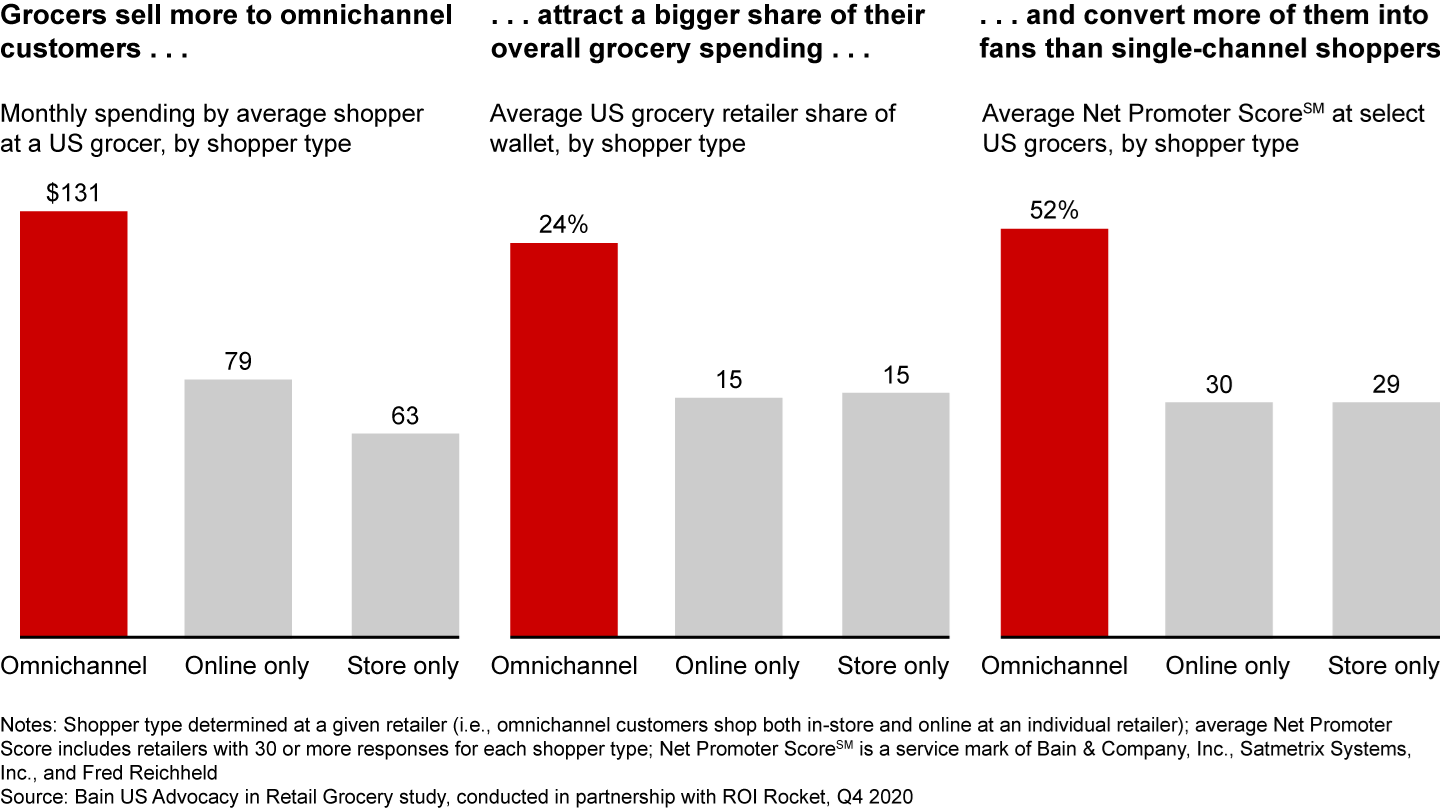
Supplier relationships are another omnichannel strength. For large consumer packaged goods makers (CPGs), incumbent grocers are more than just the largest distribution channel, accounting for the majority of their total grocery sales. They also offer standout profitability. CPGs typically enjoy a 17%–22% earnings before interest, taxes, depreciation, and amortization margin supplying omnichannel grocers. That’s typically more than double what’s on offer from other online distribution channels. No wonder the most attractive terms, such as better prices and priority restocking, are awarded to scale incumbents.
It’s clear that some customers love the speed and simplicity offered by quick commerce, even if those immediate purchases tend to come at a premium price. However, only a subset of a typical country’s population lives in catchment areas with the critical mass of shoppers that quick commerce needs to make money.
Incumbents nonetheless need to stay alert if they want to continue building and benefiting from their competitive advantage. Losing 5% of total grocery market sales to quick commerce would be challenging for scale incumbents, as these sales would be pulled from the attractive convenience format, a key source of profitable growth for omnichannel grocers in recent years.
Moreover, quick-commerce firms, many established in the last 24 months, are purpose-built to compete on the new retail battlefields of logistics and data. The insurgents’ data expertise could be particularly helpful in attempts to erode incumbents’ customer intimacy advantage. Their agility isn’t hampered by legacy ways of working and infrastructure. Nor do they face incumbents’ onerous obligation to find capital to invest in their physical stores and keep those lucrative omnichannel customers happy (while persuading online-only shoppers to venture into stores as well).
Reality #2: Fixing the economics of online grocery is an emerging priority for quick commerce too
A few months into the pandemic, we argued that the unexpected surge in demand for online grocery posed a threat to the industry because it had turbocharged a channel that was structurally less profitable than in-store transactions for most grocers (see the Bain Brief “How to Ramp Up Online Grocery—without Breaking the Bank”). We laid out how incumbent grocers could defend themselves against the threat of massive profit dilution by optimizing their omnichannel network, diversifying revenue streams, and removing unsustainable channel subsidies.
This remains an urgent task, and, on one level at least, disruptors can serve as an inspiration. Some food delivery aggregators, for instance, are doing a better job than incumbents of recouping the cost of providing an online grocery service, charging fees that more accurately reflect the convenience and other benefits enjoyed by consumers. Likewise, the mightiest grocery disruptor, Amazon, recently introduced a $9.95 delivery fee per order at its Whole Foods Market arm in the US, on top of the requirement to pay a $139 annual Prime subscription charge.
Quick commerce is also supplying examples for incumbents to emulate. For example, the £2 delivery fee charged by most quick-commerce players in the UK is small in absolute terms, but relative to the basket price it’s high—approximately 10% of the average order value, without factoring in any uplift from price markups. Rival incumbent grocers tend to charge less than 5% of the order value for home delivery.
Yet quick commerce faces an economic challenge overall. During the post-launch growth phase, the dark store model begins to make a profit on bigger orders at a contribution level (excluding the cost of acquiring customers and other indirect costs). However, the model is still clearly lossmaking in its early stages when viewed through the holistic lens of a full profit and loss statement.
For one thing, as they race to gain scale, many quick-commerce players currently depend on large discount offers to acquire customers. But it’s unclear when or, more accurately, if these promotions can be scaled back, given the essential need to win and retain new customers against the many competing offers.
Once fixed costs covering technology development, general and administrative expenses, and customer service are accounted for (benchmarked on Bain experience with food delivery players), European quick-commerce players will be looking at breakeven (at an earnings before interest and taxes level) if they can lift average order values to €30 (from about €20 today) and increase order volumes per dark store from 300–800 per day to more than 1,000 (see Figure 2).
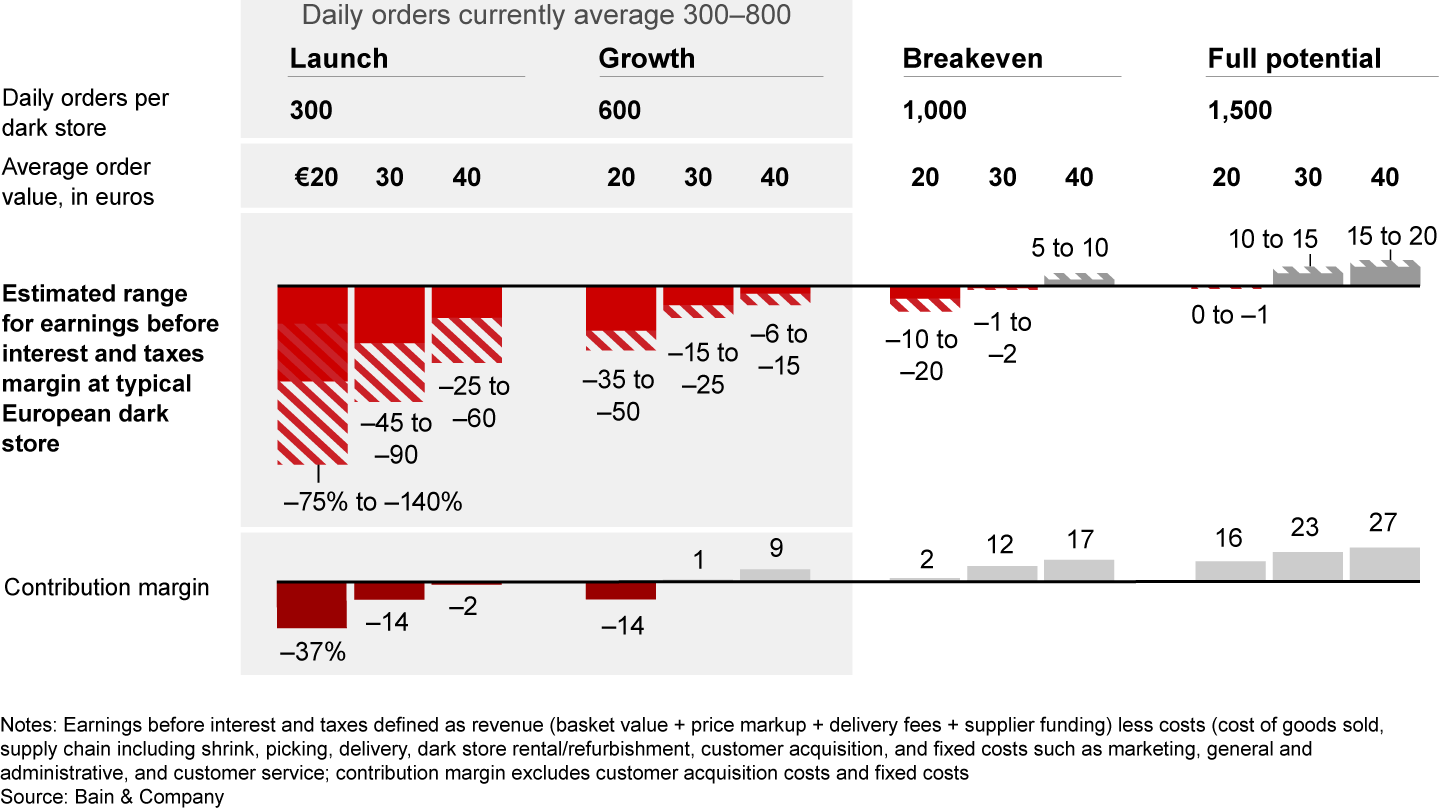

Although quick commerce has ridden the growth opportunity provided by the pandemic—all the while measuring its progress against indicators such as increase in customer base, number of orders, and average order value—growth alone will not be enough to chart a path to profitability. The underlying model needs to mature.
Improvements need to be found across the board: higher average order values and higher-margin baskets (without slowing down picking); better supplier terms; faster picking and delivery (think 10 picks and 5 drops per hour); dynamic pricing based on the time of day and customer price elasticity; less shrink; and fewer delivery delays and missing items (to foster loyalty and ease the obligation to invest continually in new customer acquisition).
That transition could be a tall order. Small assortments make increasing average order values more challenging, and growing orders per dark store will be harder when there are a handful of competitors within the same catchment area. What’s more, surplus picking and delivering capacity will always need to be on hand to respond to demand surges, making full-utilization economics hard to achieve. And there’s still a question mark over how many quick-commerce dark stores a single catchment area can sustain.
Another threat: food delivery apps making a lateral move from restaurant food into the adjacent territory of grocery. To cap it all, incumbents are also defending their turf with their own rapid services.
In the future, we expect to see more consolidation, both within quick commerce—as players race for scale in a winner-takes-all market—and in the form of incumbents or food delivery apps buying their way into on-demand delivery.
Reality #3: There’s no single answer to fulfillment—and some capex will be wasted
Between now and 2025, online grocery incumbents and disruptors face another common challenge. They both need to expand fulfillment capacity to handle hundreds of millions of additional orders—and that’s on top of the 2020 lockdown demand peaks (see Figure 3).
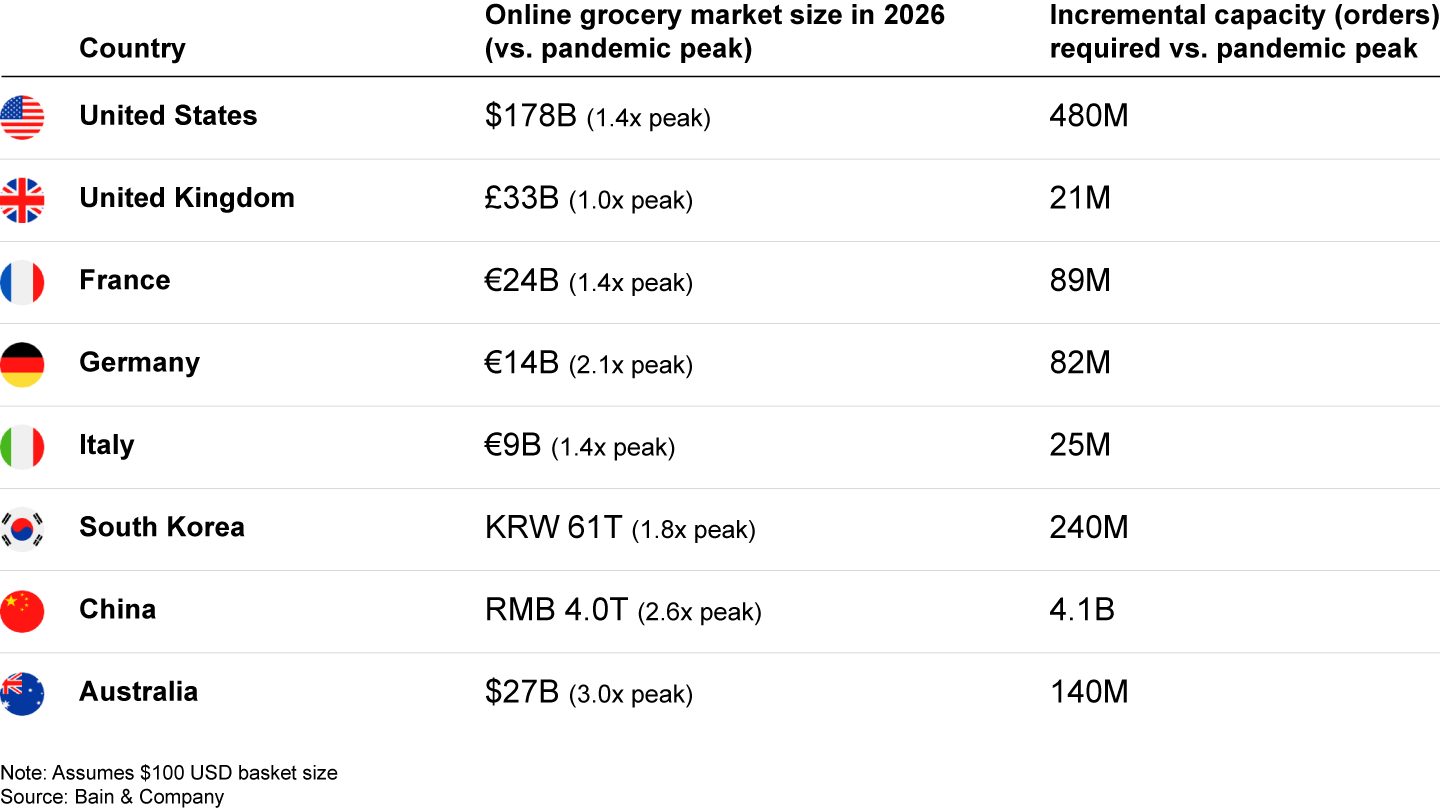
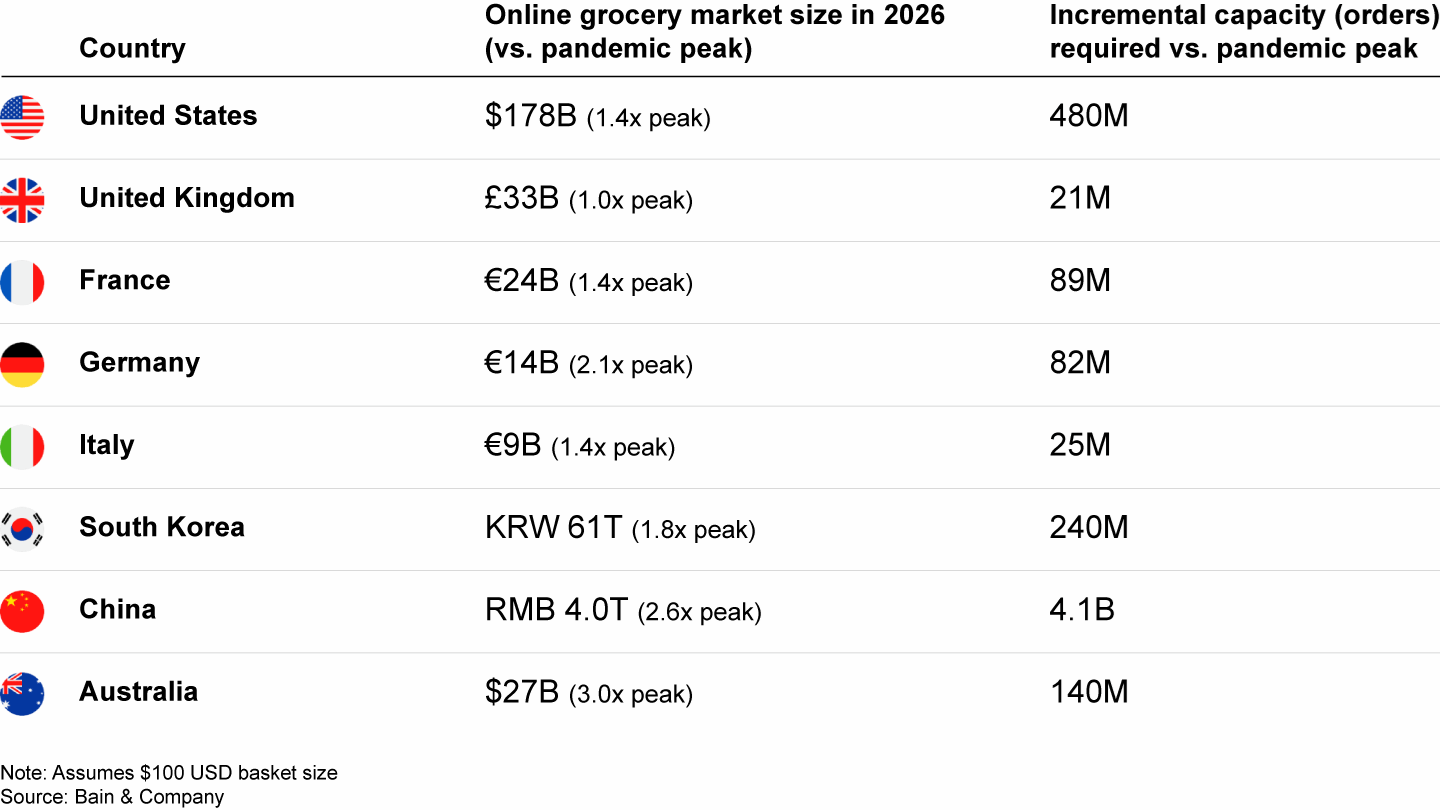
Many grocers are likely to need multiple fulfillment models according to the density of their various catchment areas, a key determinant of viability. For example, a microfulfillment center’s small-scale robotic picking makes sense in a densely populated area of a city but much less sense in a low-density small city or rural area, where in-store manual picking might be more economically viable. (For more on how fulfillment preferences vary, see the Bain infographic “Online Grocery: Moving from Enough Capacity to the Right Capacity.”)
In the pandemic, omnichannel grocers have largely added capacity via in-store picking, which is flexible and requires little capital, but it has scaling limitations and a tendency to crowd aisles, to the annoyance of shoppers. Some have chosen to team up with food delivery apps, which also offers capital-light flexibility, but with the loss of margin, customer touchpoint, and data.
Emerging into the pandemic recovery, executive teams should give special consideration to automated fulfillment centers for the densest catchment areas. (The likes of Walmart, Carrefour, and Ahold Delhaize have already been trialing automated solutions with partners.)
Automation can give omnichannel grocers a route to online profitability, albeit with a risk of cannibalizing more profitable in-store sales. And while the cost of building automated fulfillment centers remains high today, it’s likely to come down in the long run.
Incumbents also face a series of local decisions about last-mile delivery, which will continue to be costly in the near term. In areas where they have scale, owning the fleet and directly employing drivers can create a better customer experience and better economics. Elsewhere, partnering with a food delivery app on the last mile of delivery can offer significantly better margins and scaling flexibility. Picking should probably stay in-house, as it is central to customer experience.
As they ramp up fulfillment capacity, executive teams at all online grocers need to be willing to take risks with their capital expenditure, particularly when it comes to automation. The technology is advancing so rapidly, amid so much hype, that it’s impossible to back the winning innovation every time.
While the temptation to wait and see will be strong, there will always be at least one rival deploying cutting-edge tools and solutions. Some capex waste is an inevitable part of getting ahead of the competition.
Quick-commerce players, too, will need to adapt their service model if they selectively expand beyond the most attractive, densely populated cities (and their rich supply of independent delivery riders). In moving into the second-tier urban centers, they will have to tweak the model and relax delivery times to compensate for longer delivery distances.
Questions abound, but blurred boundaries can yield answers
The gush of money flowing into quick commerce has not abated since the start of the pandemic, and the $14 billion invested during 2021 will further alter the strategic landscape of online grocery, adding to the changes in consumer behavior already wrought by Covid-19.
While this funding is focused in the short to medium term on rapid scaling and expansion, quick-commerce players will also be obliged to solve some of the challenges of grocery delivery economics over the long term. Right now, however, it has created a new set of questions across the sector, without supplying any easy answers.
For instance, executive teams at quick-commerce players need to consider a range of moves that can address today’s strategic realities. Key questions for them include:
- Could we gain share more rapidly (and more durably) if we modify the rollout strategy to win in cities that have little in the way of a quick-commerce presence today?
- How and when do we gradually change the mix to higher-value items beyond food, beverages, and personal care? What operational changes need to be unlocked to make that happen?
- How will the competitive dynamic in the market evolve? Will further consolidation occur, and how actively do we want to drive that? Is it a winner-takes-all market?
- Amid so much external interest in the on-demand model, might a sale to a traditional grocer or food delivery aggregator realize the most value? That said, current quick-commerce valuations might well make this option prohibitively expensive for would-be buyers.
At incumbents, the pressing questions are also varied:
- Is there a quick-commerce winner emerging in our most important markets—and could we invest in that emerging champion?
- Could investing alongside venture capital enable us to learn, preempt disruptors, and share the eventual value?
- Should we expand in on-demand delivery in partnership with quick-commerce players (applying lessons from any prior partnerships with third-party aggregators)?
- How about waiting to see if cut-price infrastructure (such as a delivery network or tech platform) becomes available through a corporate failure?
- Is quick commerce a niche distraction from customers on larger-basket missions?
Each company’s response to these questions will be unique, which is one reason to be optimistic that solutions to the most intractable problems in online grocery—such as how best to configure fulfillment and last-mile delivery—will eventually emerge. Disruption may have blurred the boundaries of the sector, but it has also opened the door to new approaches that, through cycles of experimentation and iteration, can rebuild the economic foundations of online grocery for good.